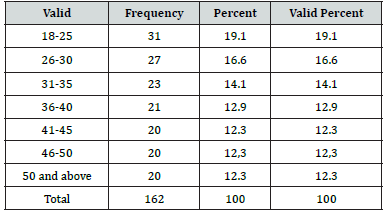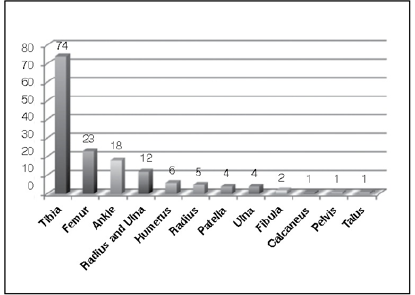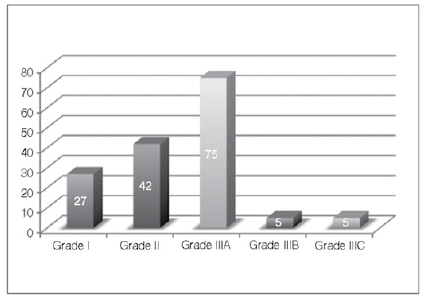Research Article 
 Creative Commons, CC-BY
Creative Commons, CC-BY
Frequency of Micro-Organisms Isolated from Culture Reports of Extremities’ Open Fractures
*Corresponding author:Imran Khan, Department of Orthopedic and Trauma, Medical Teaching Institute Lady Reading Hospital, Peshawar, Pakistan.
Received:April 20, 2023; Published:May 04, 2023
DOI: 10.34297/AJBSR.2023.18.002506
Abstract
Introduction: Open fractures still represent a major challenge for the treating surgeon and frequently demand an array of complex
procedures to achieve an undisturbed healing with adequate limb function. The incidence of infection in open fractures varies
considerably in the literature. Spencer et al. [1] showed an overall incidence of infection in open fractures to be about 10.4% whereas
Weitz-Marshall and Bosse found infection rates between 0% and 50%.
Objective: To determine the frequency of micro-organisms from culture reports of open fractures of extremities.
Materials and Methods: This was a Descriptive cross-sectional study conducted at Department of Orthopedic Surgery, Lady Reading
Hospital, Peshawar in which a total of 162 presented with open fracture having duration of fracture more than 5 days. Duration of
study was 06 months. Total sample size were162 keeping 12%5 proportion of E.Coli in open fractures with 95% confidence Interval,
5% level of significance and 5% margin of error calculated on WHO Sample Size Calculator. The sample technique was Consecutive
non-probability sampling.
Results: Age distribution among 162 patients was analyzed: 18-25 Years was 31 (19.1%) 26-30 Years was 27(16.6%) and 31-35
Years was 23(14.1%) 36-40 Years was 21(12.9%) 41-45 Years was 20(12,3%) 46-50 Years was 20(12,3%) and 50-60 Years was
20(12.3%). Mean age was 27.23 ± 3. Gender Wise Distribution among 162 patients was analyzed as 88 (54.3%) was Male and
74(45.6%) was Female. Distribution of compound fractures according to anatomic location among 162 Patients was analysed as
tibia was 74, femur was 23, ankle was 18, hand and forearm was 14 and Arm was 15 patients. Micro-organisms distribution among
162 patients was analyzed as Staphylococcus aureus was 43(26.8%) Streptococcus was 34(20.9%) Staphylococcus epidermidis was
35(21.6%) E.Coli was 26(16.0%) and Enterobacter aerogenes 24(14.8%). Distribution of compound fractures according to Gustilo
classification among 162 patients was analyzed as Grade1 was 27 Grade II was 42 Grade III was 75 Grade IIIB was 5 and Grade IIIC
was 5.
Conclusion: All Gustilo type II and type III open fractures, reached to the hospital in more than 6 hours should be considered
infected. Wound should be properly washed, and specimen taken for culture and sensitivity. The patient should be started on
intravenous first-generation cephalosporin and Aminoglycosides to cover both Gram-positive and Gram-negative organisms, till the
availability of the culture and sensitivity reports.
Keywords: Frequency, Common organisms, Culture reports, Open fractures of extremities
Introduction
An open fracture still represents a major challenge for the treating surgeon and frequently demands an array of complex procedures to achieve an undisturbed healing with adequate limb function. The incidence of infection in open fractures varies considerably in the literature. Spencer et al. [1] showed overall incidence of infection in open fractures to be about 10.4% whereas Weitz-Marshall and Bosse found infection rates between 0% and 50% [2]. The procedure for evaluation and management of open fractures is best described as a set of principles that has evolved over time, often in relation to advances in wartime care of military personnel. These principles involve both initial management and subsequent surgical intervention [3].
The first step is accurate diagnosis and documentation of the mechanism of injury. Appropriate coverage of the wound and splinting of the fracture are performed in conjunction with initiation of appropriate antibiotic therapy and tetanus prophylaxis. Urgent surgical intervention typically follows and involves both soft tissue and bone management. Adjuncts to the care of open fractures have evolved and often involve delivery of antibiotics or metabolically important substances to the local fracture environment. [4,5] In one study, according to the culture reports, 27 (54%) cases were Gram-positive. The most common was Staphylococcus aureus 32% and 18%Streptococcus.One case was with staphylococcus epidermidis and one with MRSA. Twelve cases (24%) were having Gram-negative organism with the most common E.colie 12%. Mixed growth was obtained from 6 (12%) of the cases, including a case with MRSA and Enterobactor arogenosa. Five cases (10%) yield no growth [6]. Open fracture wounds are contaminated wounds and postoperative infection is the main complication. Communication of the fractured bone fragments to the external environment, severity of the fracture, patient co-morbidities, the presence of devascularized soft tissue, and the delay in treatment contribute to the risk of bacterial infection [7].
Open fractures are a big challenge for surgeons to treat due to wound contamination leading to infection is a well-established complication. To overcome this complication, prophylactic antibiotic therapy is routinely recommended for open fractures [8]. In one another study, among the 60 patients with 64 open fractures, there were 15 (23.43%) cases of infection overall. Road traffic accidents predominated 48 (75%) as mode of injury. There was a change in wound flora over the period of hospital stay. The mean duration of final wound coverage was 5.66 days. Rate of infection increased with increase in trauma to final wound coverage interval [9]. The purpose of this study is to determine the frequency of organisms from culture reports of open fractures of extremities.
Material and Methods
This was a Descriptive cross-sectional study conducted at Department of Orthopedic Surgery, Lady Reading Hospital, Peshawar in which a total of 162 were presented with open fracture having duration of fracture more than 5 days from August 2020 to February 2021. Total sample size were162 keeping 12%5 proportion of E. Coli in open fractures with 95% confidence Interval, 5% level of significance and 5% margin of error calculated on WHO Sample Size Calculator. The sample technique was Consecutive non-probability sampling. Patients having age between 18 to 60 Years presented with open fracture as per operational definition having duration of fracture more than 5 days with either gender were included in the study while Patients having life-threatening head, abdominal or chest injuries, those with mental illness, burns or systemic illnesses, or immunocompromised status and Patients who later due to trauma or had indication for immediate amputation were excluded from the study.
After taking approval from Hospital Ethical Committee, all the patients admitted as emergency patients meeting inclusion criteria were included in the study. Prior to the conduct of the study, written informed consent will also be obtained from all patients. After wound evaluation and grading of fracture according to Gustilo and Anderson Classification (Annex B). Treatment for management of open fractures was carried out as per our departmental protocol. Wounds were irrigated in the emergency department. Wound swabs were taken for culture and sensitivity after surface cleaning and were repeated at 1-week intervals except when definitive wound closure is carried out. Intravenous (IV) broad spectrum antibiotics were given in the form of injection amoxicillin + clavulanic acid 1.2 g BD, injection amikacin 500 mg OD, injcetion metronidazole 500 mg TDS for minimum of 5 days after surgical debridement. Intraoperative wound debridement was carried out within 6 h of presentation to hospital and irrigation with 3 liters of saline per Gustilo grade. Primary wound closure was carried out if wound permits. Secondary wound closure will also be carried out in cases of heavily contaminated wounds. In case of delayed wound closure or wound coverage because of burden of patients, wound dressing was carried out after every 48 h. For larger defects, either skin grafting or flap coverage for wound were carried out done as early as possible. Fixation comprising of either internal fixation and external fixation or cast immobilization will also be carried out. Analgesics and IV fluids were given on as and when on required basis. Infection was documented irrespective of the type of closure or fixation and irrespective of culture results. Data were analyzed in SPSS version 22. Mean ± SD were calculated for numerical variables like age. Frequencies and percentages were calculated for categorical variables like gender, site of injury, grading of open fracture and micro-organisms. Micro-Organisms were stratified among age, gender, site of injury, grading of open fracture in order to see effect modifiers. Post stratification chi square test were carried out keeping P Value <0.05 as significant. All results were presented in the form of tables and graphs.
Results
This was a Descriptive cross sectional study conducted at Department of Orthopedic Surgery, Lady Reading Hospital, Peshawar in which a total of 162 presented with open fracture as per operational definition having duration of fracture > 5 days the results were analyzed as Age distribution among 162 patients was analyzed: 18-25 Years was 31 (19.1%) 26-30 Years was 27(16.6%) and 31-35 Years was 23(14.1%) 36-40 Years was 21(12.9%) 41-45 Years was 20(12,3%) 46-50 Years was 20(12,3%) and 50-60 Years was 20(12.3%). Mean age was 27.23 ± 3. (As shown in Table 1)
*Note: The mean age of patients was 27.23 ± 3.633.
Gender Wise Distribution among 162 patients was analyzed as 88 (54.3%) was Male and 74(45.6%) was Female. (As shown in Table 2).
Distribution of compound fractures according to anatomic location among 162 Patients was analyzed as tibia was 74 femur was 23 ankle was 18, hand and forearm was 14 and Arm was 15 (as Shown in Figure 1).
Microorganisms’ distribution among 162 patients was analyzed as Staphylococcus aureus was 43(26.8%) Streptococcus was 34(20.9%) Staphylococcus epidermidis was 35(21.6%) E Coli was26(16.0%) and Enterobacter aerogenes 24(14.8%) (as shown in Figure 2).
Distribution of compound fractures according to Gustilo classification among 162 patients was analyzed as Grade1 was 27 Grade II was 42 Grade III was 75 Grade III b was 5 and Grade III 3 c was 5(as shown in Table 3-8)
Discussion
Treatment of compound fractures has been the subject of controversy. In hospitals treating patients suffering from trauma, there is consensus that the initial treatment of these fractures should ideally be held in less than 6 hours. This theory is based on the work by Friedrich 4 who used garden soil and dust as infectious agents to wounds in experimental animals. In his study he demonstrated that the initial phase of bacterial growth in contaminated wounds terminates within 6 to 8 hours after inoculation. After this time, debridement would be less effective to control the wound infection. Friedrich then recommended cleaning and circumferential excision of the wound edges within 6 hours [10].
For various reasons, not always surgical debridement can be done within the first 6hours. In some cases, the procedure is performed by overwhelmed and tired surgeons and anesthetists at inappropriate times [11,12]. A waiting time between 6 and 24h for the surgical treatment of compound fractures can allow better preoperative planning of the definitive treatment fractures, better recognition of the severity of associated injuries, and therefore adequate clinical stabilization. In the current literature, there is no scientific evidence reporting that the delay in surgical debridement interferes in the incidence of infection.
Observational studies have shown an association between the incidence of infection and severe fractures, according to Gustilo and Anderson classification [12,13] and those involving leg bones, this fact was also observed in this study. It is noteworthy that in less serious fractures (Grade I and II) we observed four infections and in those operated after 6 hours no infection was observed, showing that the time was not the only determining factor, i.e. the severity of injuries should always be considered. We, therefore, recommend that more severe fractures must be operated on as soon as possible. It drew our attention to the high incidence of infection in ankle fractures, where of the 18 fractures, 27.7% developed infection, a large number when compared with fractures of the leg bones, which 16.9% of the 65 fractures infected. This group alone was not researched isolated, but it would take more studies to better assess the cause of this observation [14].
Few studies have been able to establish a direct relationship between infection and the delayed surgical debridement [14,15]. Other similar studies showed no direct relationship between the frequency of infection, time to surgical debridement and IV antibiotic administration [16-19]. Despite there is a possibility of a type II error (due to the limited number of cases) in the present study, we found no statistical significance between the time of debridement and the incidence of infection. Of all fractures 40.4% were operated on after 6 h of trauma, however, the reasons which led to the delay to surgical debridement were not the subject of this study. The compound fractures infection rates vary considerably in the literature. In a national study, Muller et al. [20]. found acute infectious complications in 20.5% of the fractures. Other international studies also showed similar infection rates to those found in our study, [21-23] which showed an overall incidence of 13.24%. We believe that to better assess the link between the time and the occurrence of infection, a multicenter randomized study would be necessary, but ethical principles hinder this type of analysis. We also cannot forget other factors that influence the occurrence of infection such as patient-related factors (smoking, diabetes and other co morbidities), type of fracture (severity and location of the lesion) and type of surgery (surgeon’s experience, aggressiveness debridement of devitalized tissues and type of synthesis prescribed).
Conclusions
All Gustilo type II and type III open fractures, reached to the hospital in more than 6 hours should be considered infected. Wound should be properly washed, and specimen taken for culture and sensitivity. The patient should be started on intravenous firstgeneration cephalosporin and Aminoglycosides to cover both Gram-positive and Gram-negative organisms, till the availability of the culture and sensitivity reports.
Acknowledgments
None.
Conflict of Interest
None.
References
- Spencer J, Smith A, Woods D (2004) The effect of time delay on infection in open long-bone fractures: a 5-year prospective audit from a district general hospital. Ann R Coll Surg Engl 86(2): 108-112.
- Kale AR, Sonawane CS, Waghmare VU, Kalambe H (2017) Open fractures and incidence of infection in tertiary care government hospital. Int J Sci Stud 5(5): 24-28.
- Bucholz RW, Heckman JD, Court Brown C, Charles A Rockwood, David P Green (2006) Rockwood and Green’s Fractures in Adults. 6th Philadelphia: Lippincott Williams & Wilkins.
- Beaty JH, Kasser JR, Charles A Rockwood (2005) Rockwood and Wilkins’ Fractures in Children. 5th Philadelphia: Lippincott Williams & Wilkins.
- Ruedi T, Buckley R, Moran C (2007) AO Principles of Fracture Management. New York: Thieme.
- Naeem U, Habibullah S, Amer HK (2012) Common organisms and their sensitivity, in open fractures of the Extremities. Pak J Surg 28(3): 186-192.
- Reddy Lingaraj , John Ashutosh Santoshi , Sheela Devi , Syed Najimudeen , James J Gnanadoss, et al.(2015) Predebridement wound culture in open fractures does not predict postoperative wound infection: a pilot study. J Nat Sci Biol Med. 6: S63-S68.
- Hasan O, Rahim Khan HA, Mustafa SF, Muhammad ZA, Ahmad T, et al. (2018) Use of bacterial cultures in open wound fractures: a prospective cohort study. IJS Short Rep 3: 52-57.
- Amit RK, Chandrashekhar SS, Vijay UW, Harshal K (2017) Open fractures and incidence of infection in tertiary care government hospital. Int J Sc Study 5(5): 24-29.
- Rajasekaran S, Devendra A, Perumal R, Dheenadayalan J, Sundararajan SR (2015) Initial management of open fractures. Court-Brown CM, Heckman JD, McQueen MM, Ricci WM, Tornetta P III, McKee MD, eds. Rockwood and Green’s Fractures in Adults. 8th ed. Philadelphia: Wolters Kluwer Vol 1: 353-396.
- Carmont MR (2005) The Advanced Trauma Life Support course: a history of its development and review of related literature. Postgrad Med J 81(952): 87-91.
- Carley S, Driscoll P (2001) Trauma education. Resuscitation 48(1): 47-56.
- Collicott PE (1992) Advanced Trauma Life Support (ATLS): past, present, future-16th Stone Lecture, American Trauma Society. J Trauma 33(5): 749-753.
- Bosch F, Rosich L (2008) The contributions of Paul Ehrlich to pharmacology: a tribute on the occasion of the centenary of his Nobel Prize. Pharmacology 82(3): 171-179.
- Kindsfater K, Jonassen EA (1995) Osteomyelitis in grade II and III open tibia fractures with late debridement. J Orthop Trauma 9(2): 121-127.
- Bednar DA, Parikh J (1993) Effect of time delay from injury to primary management on the incidence of deep infection after open fractures of the lower extremities caused by blunt trauma in adults. J Orthop Trauma 7(6): 532-535.
- Noumi T, Yokoyama K, Ohtsuka H, Nakamura K, Itoman M, et al. (2005) Intramedullary nailing for open fractures of the femoral shaft: evaluation of contributing factors on deep infection and nonunion using multivariate analysis. Injury 36(9): 1085-1093.
- Skaggs DL, Friend L, Alman B, Chambers HG, Schmitz M, Leake B, Kay RM, et al. (2005) The effect of surgical delay on acute infection following 554 open fractures in children. J Bone Joint Surg Am 87(1): 8-12.
- Arruda LRP, Silva MAC, Malerba FG, Fernandes MC, Turíbio FM, Matsumoto MH (2009) Fraturas expostas: estudo epidemiológico e prospectivo. Acta Ortop Bras17(6): 326-330.
- Müller SS, Sadenberg T, Pereira GJC, Sadatsune T, Kimura EE, Novelli JLV (2003) Filho Estudo epidemiológico, clínico e microbiológico prospectivo de pacientes portadores de fraturas expostas atendidos em hospital universitá Acta Ortop Bras 11(3): 158-169.
- Swanson TV, Szabo RM (1991) Anderson DD. Open hand fractures: prognosis and classification. J Hand Surg Am 16(1): 101-107.
- Taffinder NJ, McManus IC, Gul Y, Russell RC, Darzi A, et al. (1998) Effect of sleep deprivation on surgeons' dexterity on laparoscopy simulator. Lancet 352(9135): 1191-1191.
- Arnedt JT, Owens J, Crouch M, Stahl J, Carskadon MA (2005) Neurobehavioral performance of residents after heavy night call vs after alcohol ingestion. JAMA 294(9): 1025-1033.













 We use cookies to ensure you get the best experience on our website.
We use cookies to ensure you get the best experience on our website.